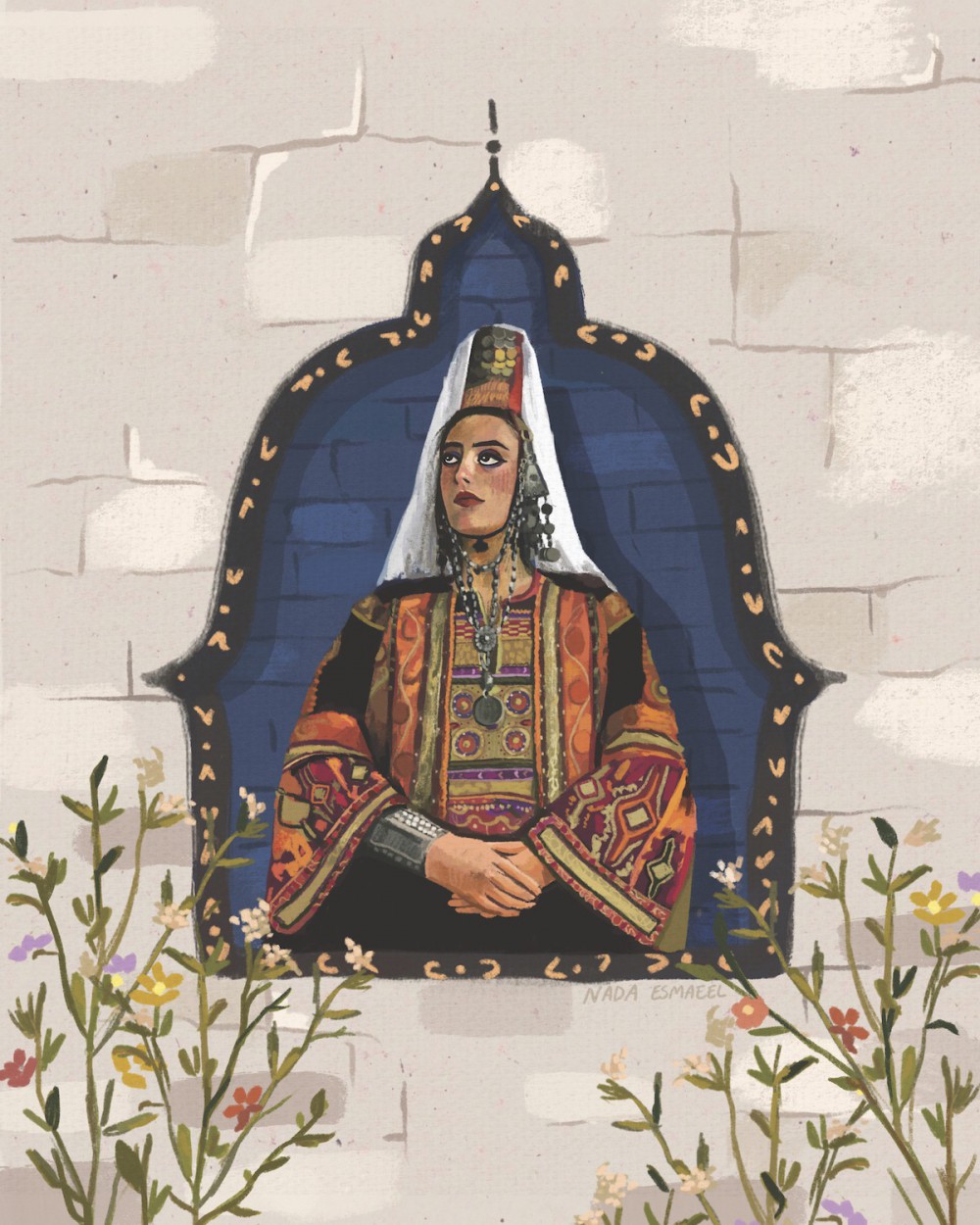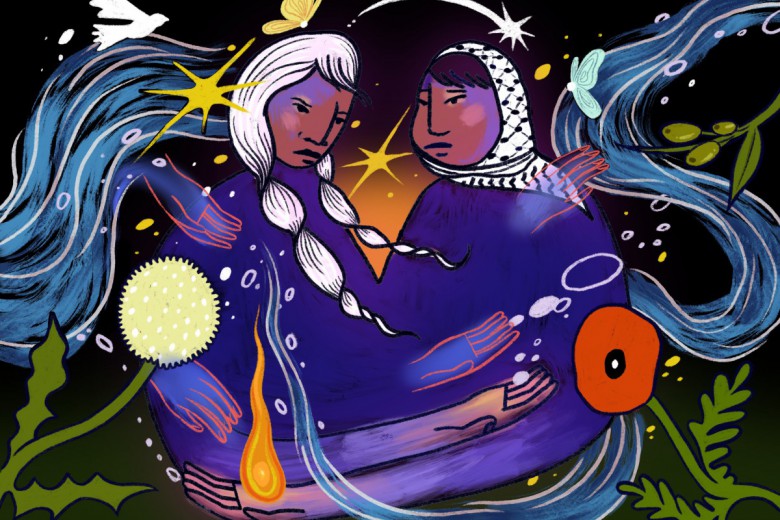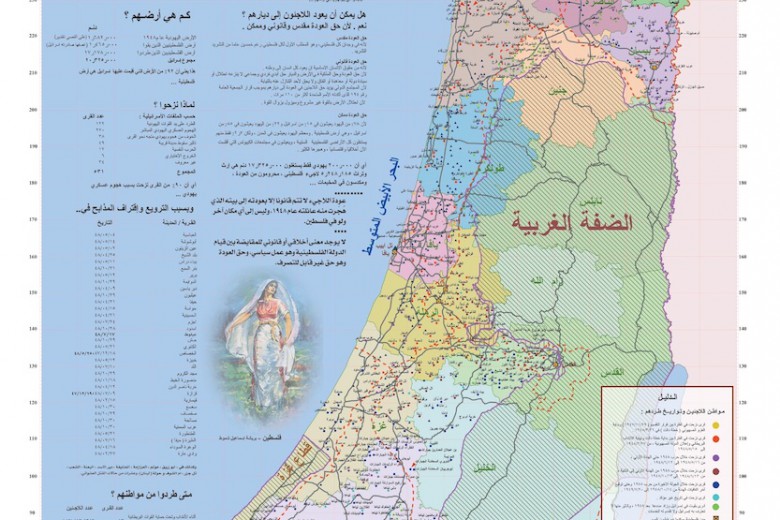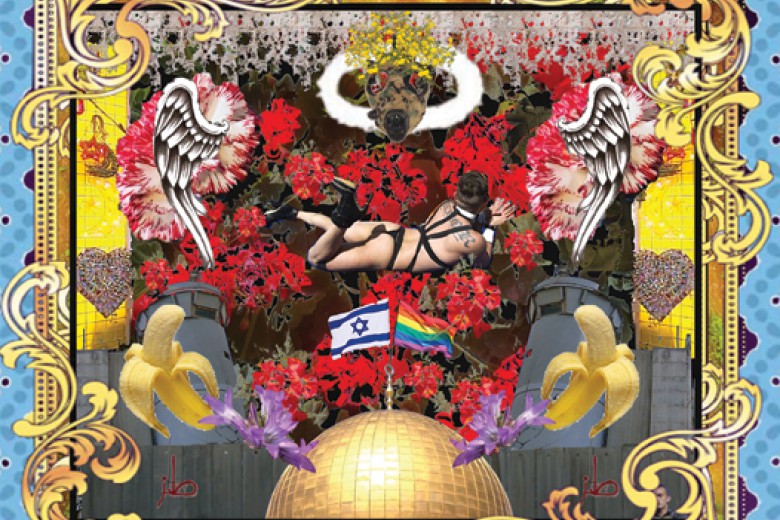
"Woman of Bethlehem" by Nada Esmaeel
In “The Deluge and the Tree,” Palestinian feminist poet Fadwa Tuqan writes about the unbreakable connection between Palestinian people and the land:
When the hurricane swirled and spread its deluge
of dark evil
onto the good green land
‘they’ gloated. The western skies
reverberated with joyous accounts:
“The Tree has fallen!
The great trunk is smashed! The hurricane leaves no life in the Tree!”Had the Tree really fallen?
Never! Not with our red streams flowing forever,
not while the wine of our thorn limbs
fed the thirsty roots,
Arab roots alive
tunneling deep, deep, into the land!When the Tree rises up, the branches
shall flourish green and fresh in the sun,
the laughter of the Tree shall leaf
beneath the sun
and birds shall return.
Undoubtedly, the birds shall return.
The birds shall return.
The prospect of Palestinian liberation is not far-fetched – it’s something we work toward every day. We know that Palestine will be liberated from Zionist settler colonialism within our lifetime.
Our vision of liberation includes the liberation of Palestinians of all genders. Like others before us, we assert that Palestine is a feminist issue, that there is no free homeland without free Palestinian women. Women, especially working-class women, have been at the forefront of the Palestinian national liberation struggle. We offer a gender-based analysis of Zionist and comprador violence in Palestine and, through interviews with women on the ground in different areas in Palestine, we put forward a feminist vision of liberation.
How settler colonialism works
Zionist settler colonialism seeks to expel and displace the land’s native Palestinian population. Syrian-Palestinian scholar Fayez Sayegh defines the Zionist settler ethnostate through its three foundational characteristics: expansionism, racism, and addiction to violence. The violent elimination of all non-Jews from Palestine is essential to the Zionist project of Jewish ethnic exclusivity.
Our analysis will focus on the gendered violence of the Israeli occupation and some of its arms, including the Palestinian Authority. Although this type of analysis is typically regarded as feminist, we also know how feminism has been weaponized against our communities in the Global South: when it comes to Palestine, “women’s rights” have been invoked as a reason to invade our lands and dispossess our people, painting Arab and Muslim people – specifically men – as barbaric.
Zionist feminism specifically has been used to entrench the occupation. The Zionist military uses its female soldiers to sanitize its violence against Palestinians, claiming that including women in the Israeli Occupation Forces (IOF, a more honest name for the Israeli Defense Forces) is a testament to the progressiveness of the Israeli state. This tactic is “purplewashing,” a term used when a state appeals to feminism or women’s rights to distract from its violence and abuses.
When it comes to Palestine, “women’s rights” have been invoked as a reason to invade our lands and dispossess our people, painting Arab and Muslim people – specifically men – as barbaric.
For this reason, we’ll focus on Zionist settler colonialism as a material basis for gendered violence. A settler-colonial analysis also reminds us that colonialism stems not only from the Israeli state, but also from the Palestinian bourgeoisie, which serves to suppress working-class Palestinians and the Palestinian peasantry. In this case, the national bourgeoisie is the Palestinian Authority (PA), a comprador government that works to safeguard the Israeli state’s interests while making empty promises of “statehood” or “peace.” The PA, whose material interests align with the Zionist project, is an extension of the occupation and reproduces the ideological and repressive state apparatuses of the settler-state. The PA was born out of the Oslo Accords, a declaration of principles signed by the Palestine Liberation Organization (PLO) and the Israeli settler state, as an interim governing body that would precede the illusory two-state solution. In the infamous photo taken after the first Oslo Accords were signed, the PLO’s then-chairman, Yasser Arafat, shakes hands with the Zionist occupation’s then-prime minister, Yitzhak Rabin, overseen by then-U.S. president Bill Clinton. The dynamic in that photo persists today: The PA has no interest in Palestinian national liberation and is instead committed to serving as an arm of Zionist settler colonialism.
Violence against women, men, and boys
The occupation has brought violence into the lives of Palestinian women in countless ways. A 2008 report by Palestinian non-profit SAWA describes the trafficking of Palestinian women and girls as young as 12 into the sex trade throughout historic Palestine. Because the occupation has decimated Palestine’s agricultural and industrial sectors, the authors write that “increasing economic insecurity and higher levels of unemployment and poverty” make women “extremely vulnerable to be exploited by the recruiters and traffickers.”
In the occupation’s prisons, there are fewer Palestinian women than men – 33 of the roughly 4,400 total political prisoners are women – but they face particularly violent and dehumanizing treatment. Palestinian women prisoners have been subjected to psychological torture, sexual violence, and beatings, in addition to medical neglect and malnutrition. Imprisoned in August 2002, a then-25-year-old Palestinian woman described IOF soldiers threatening to rape her during her interrogation, at the end of which she says she was forced to sign a confession written by her interrogators. Rasmea Odeh, a former member of the Popular Front for the Liberation of Palestine (PFLP), recalls the first question her sister asked when she visited the Almaskubiah prison where Odeh was being held in 1969: “Did they really dishonour you?” Odeh responded, “My honour is my country, which I will never give up and will never sacrifice.”
“If a woman is being abused by her husband, and she wants to report the domestic abuse, she has two problems: the first being the domestic abuse, and the second being reporting this abuse to the Zionist authorities.”
This type of violence targets women as part of the larger goal of breaking up Palestinian families. Palestinian women prisoners are often denied visits or phone calls from family members, and prisoners’ families must provide permits to even reach the prisons in which their loved ones are held. In 2021, when Palestinian political prisoner Khalida Jarrar’s daughter, Suha Jarrar, suddenly died, Israeli authorities refused to release Khalida so she could attend her daughter’s funeral.
Hala Marshood says that she considers “women as an entry point” to conversations about gendered violence in Palestine, but that the Zionist occupation also targets men and boys based on their gender and their role in the Palestinian family. Palestinian boys as young as 14 are killed for throwing rocks. Since 1967, over one million Palestinians have been arrested by Zionist authorities – 98 per cent of them men or boys. By kidnapping and incarcerating Palestinian men, the Zionist entity knows that the family will be psychologically and financially destabilized.
Marshood is a member of Tal’at, a women’s organization in the territories occupied after the 1948 Nakba, that mobilizes against gender-based violence. Importantly, Tal’at is one of the few grassroots local organizations that operates throughout Palestine as a whole – both in territories controlled by the Israeli settler colony as well as by the PA. Organizations like Tal’at fight against gendered violence on both fronts.
“The occupation understands [the dilemma Palestinian women face] and knows how to take advantage of it,” Sara asserts. “They claim to be on her side, ask her to renounce the patriarchal backwardness of [Palestinian] society.”
Sara, a Palestinian lawyer and master’s student from Jerusalem who asked to use a pseudonym, shares a harrowing story of gendered violence under occupation. “If a woman is being abused by her husband, and she wants to report the domestic abuse, she has two problems: the first being the domestic abuse, and the second being reporting this abuse to the Zionist authorities.”
If Palestinian women report domestic violence to Zionist authorities, the violence is characterized as an inherent part of Palestinian society. In reality, it is a structural issue, one that is inherent to settler colonialism. Breaking generational trauma is exceptionally difficult under occupation: without access to basic needs like health care and freedom of movement, Palestinians cannot materially shift their relations to each other. Reporting to Zionist authorities only risks putting more Palestinian men in Zionist jails, which is the colonizer’s goal. “The occupation understands [the dilemma Palestinian women face] and knows how to take advantage of it,” Sara asserts. “They claim to be on her side, ask her to renounce the patriarchal backwardness of [Palestinian] society.” As abolitionist feminists such as Ruth Wilson Gilmore have taught us, we cannot appeal to the state to end gendered violence, because the state itself carries out violence in the form of prisons, police, and warfare.
Liberation as a reality
“They do not only occupy our land; they also occupy our minds, our spirit,” says Aseel Kabariti, a photographer and artist based in Gaza.
Instilling hopelessness is a critical part of sustaining the settler-colonial project. Anti-colonial philosopher Frantz Fanon wrote that the “emphasis is on the body, which is broken in the hope that the national consciousness will disintegrate. The individual is ‘knocked’ into shape [by the occupying force].” The land is seen as rapeable – olive groves razed, settler sewage dumped into Palestinian valleys, Gaza bombarded with toxic chemicals – in the same ways that Palestinian bodies are seen as rapeable and discardable. For the colonizer, the land is merely a resource – not the source of sustenance, ancestral memory, and the place of belonging it constitutes for the Indigenous population.
“The Zionist movement’s imaginary of conquering and settling the Palestinian body is inseparable from the project of conquering and settling Palestinian land, and erasing indigenous presence,” write Nadera Shalhoub-Kevorkian, Sarah Ihmoud, and Suhad Dahir-Nashif in Jadaliyya. In an attempt to reclaim our bodies and, by extension, our lands, we asked our interviewees about the relationship between their bodies and the land.
Our liberation requires that we reclaim our relationship to the land itself, navigate the ways in which it has changed, and continue to care for it in this new context.
For Sara, the uprisings during the summer of 2021 – protesting the eviction of Palestinian families from the village of Sheikh Jarrah – changed her ability to imagine Palestinian feminist futurities. “Standing together in Sheikh Jarrah and Bab al-Amud [Damascus Gate], I felt like something changed, something shifted,” she says. Typically, women and men are expected to remain separate in public spaces – especially religious spaces in Jerusalem. But at the protests, Sara continues, “There was a unity that went beyond cis-heteronormative norms. I felt like my relationship with Jerusalem [as a Palestinian woman] was now requited.” Standing together with Palestinians of all genders, Sara allowed herself to begin envisioning a liberated Palestinian future that includes freedom from patriarchy and Israeli settler colonialism alike.
How, then, do our current realities shape our vision of a liberated future in our homeland? Our liberation requires that we reclaim our relationship to the land itself, navigate the ways in which it has changed, and continue to care for it in this new context. Envisioning a liberated homeland entails imagining liberated Palestinian women, who are freed from their role as the steadfast defender of the collective homeland and are finally able to experience the mundanities of daily life with dignity.
Palestinian futurisms
Inspired by Afro- and Indigenous futurisms, we asked interviewees what their idea of a Palestinian future would entail. A future free from Zionist settler colonialism and PA cronyism. A future free of patriarchal violence. The idea of Palestinian futurisms is relatively new, both to those living in Palestine and those discussing national liberation in the diaspora. Palestinian futurism is about the dream of liberated lands and peoples, but also about the desire to continue working toward liberation for all oppressed peoples.
In the last year, Palestinians have watched Zionist violence escalate: expulsions in Sheikh Jarrah, Bedouin farming land razed in Naqab, settler arson in Khalil. For our interviewees, the closeness of this violence made it difficult to envision a liberated Palestinian future. Marshood cautions us that “Palestine can be liberated from settler colonialism and still have issues.” She notes that a Palestinian future requires a “continuous desire and motivation to change [social relations and material conditions], and needs to be ignited all the time.”
“When we are under oppression, we internalize the standards set by the occupation,” Marshood says. “I think it’s so hard to imagine a reality you have never experienced, to even allow yourself to imagine it.”
"Freedom is being able to see our mountains and our seas. Freedom is being able to freely take photographs and not feel restricted to one area.”
For Kabariti, envisioning the future was a bit more difficult living in Gaza. She tells us that a Palestinian future consists of “a place that gives people their rights, a place that does not make you feel humiliated, and a Palestine where people are allowed to enter and move freely. […] Freedom is being able to see our mountains and our seas. Freedom is being able to freely take photographs and not feel restricted to one area.”
Palestinian futurisms look and feel different for Palestinians in different regions. For those in Gaza, it may look like the lifting of the siege on Gaza. For those in the 1948 occupied territories, it may look like better civil rights. For others, Palestinian futurism is about fighting alongside other oppressed people. For instance, during the 2014 Black Lives Matter uprisings against police brutality in Ferguson, Missouri, Palestinians on the ground tweeted tactics for dealing with tear gas to help Black organizers prepare for it.
Our ability to envision a decolonized and liberated Palestine stems from Palestinians’ steadfast rejection of the colonial state structures set up by the Zionist project. As in Fadwa Tuqan’s poem, it is about re-rooting and reclaiming our body’s relationship to the land itself. Imagining our liberation as reality is therefore an act of resistance that is central to our faithful struggle for national liberation. As Tuqan writes, “Undoubtedly, the birds shall return. The birds shall return.”




_780_520_s_c1.png)

